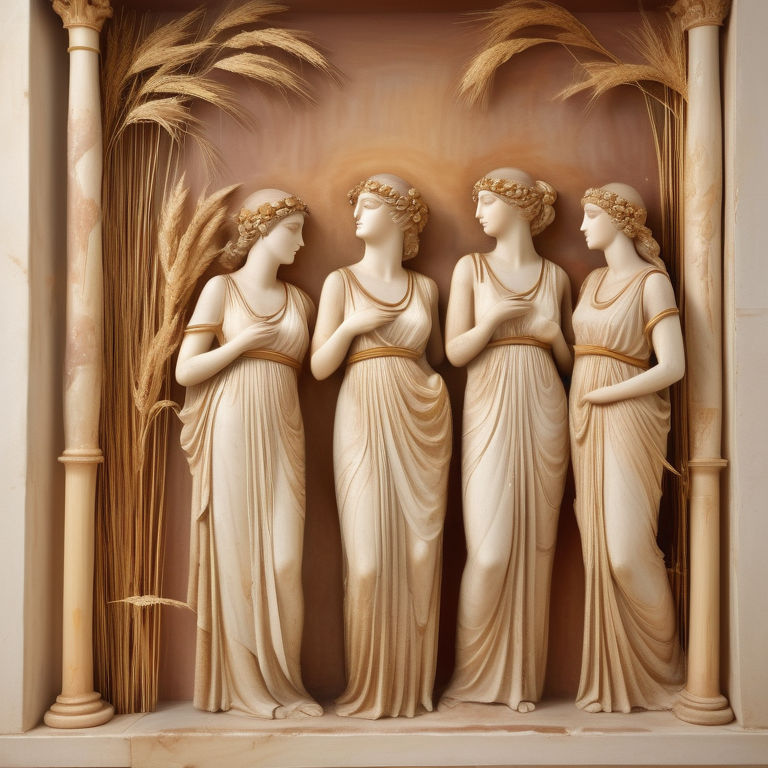Women’s Sexuality in Ancient Civilizations

Key Highlights
- Ancient civilizations had diverse perspectives on women’s sexuality, ranging from acceptance and celebration to control and subjugation.
- Women in ancient Greece and Rome had limited sexual freedoms compared to men, with societal expectations and cultural norms dictating their roles and behaviors.
- The cult of Isis in ancient Egypt celebrated female sexuality and fertility, with sexual rituals performed by queens and priestesses.
- In ancient Greece, the worship of Aphrodite and the roles of Spartan women and Athenian wives highlighted the complex dynamics of female sexuality.
- Roman society had a dichotomy between public morality and private indulgences, with Vestal Virgins representing the ideal of female purity and concubinage providing sexual fulfillment for men.
- The transition of sexual norms through time reflects the shift from matriarchal societies to patriarchal dominance, with the Renaissance marking a period of change in women’s sexual identity.
Introduction
In ancient civilizations, the topic of women’s sexuality was both complex and intriguing. From the ancient world of Greece and Rome to the mystique of ancient Egypt, the treatment of female sexuality varied greatly. Female sexuality in ancient civilizations was influenced by factors such as religious beliefs, societal norms, and the roles women played in these societies. Understanding the ancient perspective on women’s sexuality provides valuable insights into the historical context and sheds light on the experiences and challenges faced by women in these societies. This blog will explore the diverse aspects of women’s sexuality in ancient civilizations, including the defining sexual norms and practices, the intersection of sexuality with religion and mythology, and the role of women in sexual rituals. By examining the sexual autonomy and rights of women in ancient times, we can gain a deeper understanding of the evolution of women’s sexuality and its impact on society. Through the lens of myths, legends, and the perception of female sexuality, we will delve into the transition of sexual norms through time and the influence of ancient civilizations on modern perceptions of women’s sexuality.
Overview of Women’s Sexuality in Ancient Civilizations
In ancient civilizations, female sexuality was a complex and multifaceted topic. The ancient world of Greece, Rome, and Egypt had different attitudes towards female sexuality, ranging from celebration to control and subjugation. Forms of expression such as love poetry, graffiti, and interior decoration provide valuable insights into the treatment of women’s sexuality in these societies, particularly in Greek literature. Understanding the role of love poetry and other forms of erotic literature and art in ancient times, including the works of Sappho, provides valuable insights into the roles and expectations placed upon women in these societies, as seen in literary sources.
In the ancient world, sexual activity was an integral part of human life, and female sexuality was no exception. However, the cultural norms and expectations surrounding female sexuality varied greatly. In some civilizations, such as ancient Egypt, sexuality was celebrated and intertwined with religious beliefs and practices. The cult of Isis, for example, emphasized fertility and the role of women in ensuring the continuation of the human race and the family line.
In contrast, ancient Greece and Rome had more complex attitudes towards female sexuality. In Greece, the worship of Aphrodite, the goddess of love and beauty, highlighted the celebration of female sexuality. However, Spartan women had more sexual autonomy compared to their Athenian counterparts, who were expected to conform to the ideals of marriage and motherhood in cities like Athens. The earliest evidence for ancient Greek sexuality comes with the Minoans (approximately 3650 to 1400 BC), showcasing the openness and acceptance of homosexuality in the culture. The vast and diverse sexual life in ancient Greece is evident in various artifacts and depictions, such as the 6th century Kylix or drinking cup depicting “Symposiastic Orgies”. Nudity was a widely accepted aspect of ancient Greek life, showcasing the openness and acceptance of sexuality in the culture.
Roman society had a dichotomy between public morality and private indulgences. While the Vestal Virgins represented the ideal of female purity and chastity, concubinage provided avenues for sexual fulfillment for men. Love, marriage, and concubinage were intertwined in Roman society, with different expectations for men and women.
Throughout ancient civilizations, women’s sexual autonomy and rights were shaped by legislation and societal norms. The treatment of women varied across different civilizations, and the impact of legislation on women’s sexuality cannot be understated. By exploring the ancient perception of women’s sexuality through medical texts, such as those published by Cambridge University Press and referenced with a doi, we can gain insights into the struggles and experiences faced by women in ancient times.
Defining Sexual Norms and Practices
Understanding the sexual norms and practices of ancient civilizations provides valuable insights into the expectations placed upon women. Sexual acts and behaviors, including the use of sex toys, were influenced by cultural norms and societal expectations, shaping the experiences and expression of female sexuality. In fact, many modern words to describe sex acts come from antiquity. In ancient times, the concept of gender identity and sexual orientation was not as delineated as it is today. Sexual acts were often seen as a means of procreation and strengthening familial and societal bonds. The treatment of women’s sexuality varied across civilizations, with some cultures celebrating female sexual desire and others placing restrictions and control, particularly in relationships between older men and younger boys, known as pederasty. By examining the defining sexual norms and practices, we can gain a deeper understanding of the complexities of women’s sexuality in ancient times.
The Intersection of Sexuality with Religion and Mythology
Religion and mythology played a significant role in shaping the sexuality of women in ancient times. The ancient civilizations of Greece and Egypt, in particular, had rich religious and mythological traditions that influenced societal attitudes towards female sexuality. In the Ancient Greek world, goddesses such as Aphrodite and Hera represented different aspects of female sexuality, with Aphrodite symbolizing the celebration of sexuality and Hera perpetuating male insecurity and misogyny. In ancient Egypt, the cult of Isis emphasized fertility and the vital role of women in ensuring the continuation of the human race, often attributing a woman’s sexuality to the favor of the gods. The intersection of sexuality with religion and mythology, particularly in the Classical Period of Ancient Greece, provides a unique perspective on the treatment of women’s sexuality in ancient civilizations, as seen in depictions of sexual themes in Roman art and literature.
Ancient Egypt: The Cult of Isis and Fertility
Ancient Egypt had a unique perspective on female sexuality, with the cult of Isis playing a significant role in shaping societal attitudes towards women. The worship of the goddess Isis emphasized fertility and the importance of women in ensuring the continuation of the human race. By examining the cult of Isis, we can gain insights into the celebration of female sexuality and the role of women in ancient Egyptian society.
Sexual Symbolism in Egyptian Art and Literature
Sexual symbolism was prevalent in Egyptian art and literature, reflecting the cultural significance placed on fertility and female sexuality. Egyptian art often depicted sexual acts and fertility symbols, highlighting the importance of these themes in ancient Egyptian society. Some key examples of sexual symbolism in Egyptian art include:
- Phallic symbols: Images of erect penises were commonly depicted in Egyptian art as symbols of fertility and virility.
- Vulva symbols: Representations of the female genitalia were also present in Egyptian art, symbolizing fertility and female power.
- Sexual union: Images depicting sexual intercourse were often associated with fertility rituals and the concept of regeneration.
These examples demonstrate the significance of sexual symbolism in ancient Egyptian art and its connection to the celebration of female sexuality and fertility. It is through these artistic representations that we can gain a deeper understanding of the cultural values and beliefs surrounding women’s sexuality in ancient Egypt.
The Role of Queens and Priestesses in Sexual Rituals
Queens and priestesses played important roles in sexual rituals in ancient Egypt, highlighting the connection between female sexuality and religious practices. In the cult of Isis, queens and priestesses were responsible for performing sexual rituals that symbolized fertility and the continuation of life. These rituals often involved the union of male and female energies, emphasizing the importance of balance and harmony in the natural world. The role of queens and priestesses in sexual rituals reflects the reverence and celebration of female sexuality in ancient Egyptian society. By participating in these rituals, women were seen as active participants in the divine order and vital contributors to the well-being of their communities.
Ancient Greece: Goddess Worship and Women’s Roles
In ancient Greece, goddess worship played a significant role in shaping societal attitudes towards women’s sexuality. The worship of goddesses such as Aphrodite highlighted the celebration of female sexuality and the recognition of women’s desires and pleasures. Prostitutes, known as pornai, were often employed by men for sexual pleasure, but there were also hetairai, who were well-educated women hired for their skills in dance, music, and conversation. Understanding the roles and expectations placed upon women, including prostitutes and hetairai, in ancient Greece provides valuable insights into the complexities of female sexuality in this civilization, as seen through the story of Helen and her involvement in the Trojan War in Troy. Additionally, hetairai were not just hired for sexual pleasure, but also for their talents in other areas such as dance and music.
Aphrodite and the Celebration of Female Sexuality
Aphrodite, the goddess of love and beauty, played a central role in ancient Greek mythology and the celebration of female sexuality. Aphrodite was regarded as a symbol of desire, passion, and pleasure, embodying the qualities associated with the feminine. The worship of Aphrodite involved rituals and festivals that celebrated female sexuality and sensuality. Understanding the role of Aphrodite in ancient Greek society provides insights into the recognition and acceptance of women’s desires and pleasures. By examining the worship of Aphrodite, we can gain a deeper understanding of the complexities of female sexuality in ancient Greece.
Spartan Women and Athenian Marriage Practices
The roles and expectations placed upon women in ancient Greece varied across different city-states. In Sparta, women had more sexual autonomy compared to their Athenian counterparts. Spartan women enjoyed greater freedom and were encouraged to engage in physical activities to produce healthy offspring for the state. Some key aspects of Spartan women’s sexual autonomy include:
- Physical fitness: Spartan women were encouraged to exercise and maintain physical fitness to ensure healthy childbirth.
- Sexual freedom: Spartan women had more sexual freedom compared to Athenian women, with the ability to choose their sexual partners and engage in extramarital relationships.
In contrast, Athenian women were expected to conform to the ideals of marriage and motherhood. Some key aspects of Athenian marriage practices include:
- Arranged marriages: Athenian women were often married off at a young age in arranged marriages, with the primary purpose of producing legitimate heirs.
- Limited sexual autonomy: Athenian women had limited sexual autonomy and were expected to be faithful to their husbands.
These contrasting roles and practices highlight the complexities of female sexuality in ancient Greece and the diverse experiences of women across different city-states.
Ancient Rome: Public Morality vs. Private Indulgences
Ancient Rome had a dichotomy between public morality and private indulgences when it came to female sexuality. The ideal of female purity and chastity was upheld in public, while private sexual relationships and indulgences were common. This was a big part of Roman culture, as they had no reason to feel guilty about committing such acts due to their lack of a religion or political system that told them it was wrong. Understanding the complexities of female sexuality in ancient Rome, and how it was influenced by the values and beliefs of Roman culture, provides valuable insights into the societal expectations and cultural norms of this civilization.
Vestal Virgins and the Dichotomy of Female Sexuality
In ancient Rome, the Vestal Virgins represented the ideal of female purity and chastity. These priestesses were expected to remain celibate throughout their service to the state. The Vestal Virgins embodied the dichotomy of female sexuality in ancient Rome, with the public expectation of chastity contrasting with the private indulgences of sexual relationships. While the Vestal Virgins were held in high regard and revered for their purity, private sexual relationships and concubinage were common among both men and young women in Roman society. This dichotomy reflects the complex attitudes towards female sexuality in ancient Rome, with the tension between public morality and private indulgences shaping the experiences and expectations placed upon women, regardless of their family name.
Love, Marriage, and Concubinage in Roman Society
Love, marriage, and concubinage were intertwined in Roman society, with different expectations and norms for men and women. Roman society had a distinct view on love and marriage, and concubinage provided avenues for sexual fulfillment outside of marriage. Some key aspects of love, marriage, and concubinage in Roman society include the importance of bearing children to carry on the family name.
- Arranged marriages: Marriages in ancient Rome were often arranged for political or economic reasons, with little consideration for romantic love.
- Love spells and potions: Roman society saw the use of love spells and potions to manipulate romantic relationships.
- Concubinage: Concubinage was prevalent in Roman society, providing sexual fulfillment for men outside of marriage. Concubines were often slaves or lower-class women.
The text table below provides a comprehensive overview of the different aspects of love, marriage, and concubinage in Roman society:
|
Aspect |
Description |
|
Arranged marriages |
Marriages in ancient Rome were often arranged for political or economic reasons. |
|
Love spells and potions |
The use of love spells and potions was common in Roman society to manipulate romantic relationships. |
|
Concubinage |
Concubinage provided sexual fulfillment for men outside of marriage, often involving lower-class women. |
Understanding the dynamics of love, marriage, and concubinage in Roman society provides valuable insights into the complexities of female sexuality in ancient Rome.
Sexual Autonomy and Rights of Women
Sexual autonomy and the rights of women varied across ancient civilizations, reflecting the cultural norms and societal expectations of each civilization. In some ancient civilizations, women had more sexual autonomy and agency, while in others, they faced restrictions and control. Understanding the sexual autonomy and rights of women in ancient times provides valuable insights into the evolving roles and experiences of women throughout history.
In matriarchal societies, women often had greater sexual autonomy and played significant roles in decision-making processes. However, with the transition to patriarchal dominance, women’s sexual autonomy and rights were often curtailed. Legislation and societal norms played a crucial role in shaping women’s sexual freedoms.
Comparing sexual freedoms across ancient civilizations reveals stark differences in the treatment of women. In some civilizations, such as ancient Egypt, women had more sexual agency and were celebrated for their fertility and sexual desire. In contrast, ancient Greece and Rome had more restrictive attitudes towards female sexuality, with societal expectations and cultural norms dictating women’s roles and behaviors. However, it is important to note that even in civilizations where women had more sexual autonomy, such as ancient Egypt, male sexuality was still seen as dominant and women were often objectified. This highlights the ongoing struggle for gender equality and sexual rights for women throughout history.
The impact of legislation on women’s sexuality cannot be understated. In ancient Rome, for example, legislation influenced the treatment of women and their sexual freedoms. The Lex Julia de Adulteriis Coercendis, enacted by Julius Caesar, criminalized adultery and imposed severe penalties on women who engaged in extramarital relationships. Similarly, in ancient Greece, legislation regulated women’s behavior and restricted their participation in public life, as seen in a noted legal case involving a senator who was known to wear women’s clothing. This case highlights the societal attitudes towards effeminacy and transvestism, as well as the limitations placed on women’s autonomy and rights.
Understanding the evolution of women’s sexual autonomy and rights provides insights into the historical context and the challenges faced by women in ancient times. By examining the treatment of women across different civilizations, we can gain a deeper understanding of the importance of legislation and societal norms in shaping women’s sexual freedoms.
Comparing Sexual Freedoms Across Civilizations
Comparing sexual freedoms across ancient civilizations reveals stark differences in the treatment of women. While some civilizations celebrated female sexuality and granted women more sexual autonomy, others imposed restrictions and control. Some key differences in sexual freedoms across civilizations include:
- Ancient Egypt: Women had more sexual agency and were celebrated for their fertility and sexual desire.
- Ancient Greece: Women’s sexual autonomy varied across different city-states, with Spartan women having more freedom compared to Athenian women.
- Ancient Rome: Roman society had a dichotomy between public morality and private indulgences, with restrictions on women’s sexual behavior.
These differences highlight the complexities of female sexuality in ancient civilizations and the influence of cultural norms and societal expectations. Understanding the treatment of women across civilizations provides valuable insights into the evolving roles and experiences of women throughout history.
The Impact of Legislation on Women’s Sexuality
Legislation played a significant role in shaping women’s sexuality in ancient civilizations. The laws and regulations imposed by ancient societies influenced the treatment of women and their sexual freedoms. For example:
- Ancient Rome: The Lex Julia de Adulteriis Coercendis, enacted by Julius Caesar, criminalized adultery and imposed severe penalties on women who engaged in extramarital relationships.
- Ancient Greece: Legislation regulated women’s behavior and restricted their participation in public life, limiting their sexual autonomy.
The impact of legislation on women’s sexuality cannot be understated. These laws and regulations reflected societal attitudes towards women and shaped their roles and behaviors. By examining the impact of legislation on women’s sexuality, we can gain insights into the challenges faced by women in ancient times and the societal expectations placed upon them.
Myths, Legends, and the Perception of Female Sexuality
Myths and legends played a significant role in shaping the perception of female sexuality in ancient civilizations. The stories and narratives surrounding women in these myths and legends influenced societal attitudes and expectations. Understanding the influence of mythology on the perception of female sexuality provides valuable insights into the cultural values and beliefs of ancient civilizations.
Heroines and Villainesses: Shaping the Narrative
Myths and legends depicted female characters as heroines and villainesses, shaping the narrative around female sexuality. The portrayal of women in these stories influenced societal attitudes and expectations. Some women were depicted as powerful and independent, while others were portrayed as deceitful and dangerous. These narratives reflected the complex perceptions and expectations surrounding female sexuality in ancient civilizations. By examining the stories of heroines and villainesses, we can gain insights into the cultural values and beliefs of ancient societies and the influence of mythology on the perception of women’s sexuality.
The Influence of Mythology on Real Women’s Lives
The influence of mythology on real women’s lives cannot be understated. The stories and narratives surrounding female characters in myths and legends shaped societal attitudes and expectations towards women. Women in ancient civilizations often looked to these stories as guides for their own behavior and roles. The influence of mythology on real women’s lives can be seen in their adherence to societal norms and expectations. By examining the influence of mythology on real women’s lives, we can gain insights into the complexities of female sexuality in ancient times and the ways in which women navigated societal expectations and cultural beliefs.
The Transition of Sexual Norms Through Time
The transition of sexual norms through time reflects the evolution of societal attitudes towards women’s sexuality. From matriarchal societies to patriarchal dominance, the treatment of women and their sexual autonomy has undergone significant changes throughout history, particularly in medieval Europe and later in the 20th and early 21st centuries in Western Europe. Understanding the transition of sexual norms in medieval Europe provides valuable insights into the historical context and the challenges faced by women in different time periods.
In matriarchal societies, women often held positions of power and had greater sexual autonomy. These societies celebrated female sexuality and recognized women’s desires and pleasures. However, with the rise of patriarchal dominance, women’s sexual autonomy and rights were often curtailed. The transition from matriarchal to patriarchal societies marked a shift in power dynamics and the treatment of women.
The Renaissance marked a period of change in women’s sexual identity, with the emergence of new ideas and perspectives on female sexuality. Women’s sexual desires and pleasures were explored in literature and art, challenging traditional societal norms and expectations. The Renaissance provided a platform for women to express their sexuality and assert their agency.
The transition of sexual norms through time also reflects the changing understanding of gender identity and the rejection of the gender binary. In ancient times, the concept of gender identity and sexual orientation was not as delineated as it is today. Sexual acts were often seen as a means of procreation and strengthening familial and societal bonds. However, with the progression of time, society has come to recognize the diversity of gender identities and sexual orientations.
Understanding the transition of sexual norms through time provides valuable insights into the historical context and the challenges faced by women in different time periods. By examining the evolution of societal attitudes towards women’s sexuality, we can gain a deeper understanding of the impact of historical change on women’s experiences.
From Matriarchal Societies to Patriarchal Dominance
The transition from matriarchal societies to patriarchal dominance marked a significant shift in the treatment of women and their sexual autonomy. In matriarchal societies, women held positions of power and had greater sexual autonomy. Female sexuality was celebrated and recognized as an essential aspect of life. However, with the rise of patriarchal dominance, women’s roles and expectations shifted, and their sexual autonomy was often curtailed. The transition from matriarchal to patriarchal societies reflected a shift in power dynamics and the control of women’s sexuality. Understanding this transition provides valuable insights into the historical context and the challenges faced by women in different time periods.
The Renaissance of Women’s Sexual Identity in Literature
The Renaissance marked a period of change in women’s sexual identity, with the emergence of new ideas and perspectives on female sexuality. Women’s desires and pleasures were explored in literature and art, challenging traditional societal norms and expectations. Female writers and artists of the Renaissance period expressed their sexuality and asserted their agency, influencing the perception of women’s sexuality. The Renaissance provided a platform for women to reclaim their sexual autonomy and challenge societal expectations. By examining the Renaissance of women’s sexual identity in literature, we can gain insights into the historical context and the ways in which women navigated societal norms and expectations.
Conclusion
In essence, exploring the intricacies of women’s sexuality in ancient civilizations unveils a tapestry of norms, rituals, and freedoms that have both shaped and reflected societal values. From the divine reverence in Egypt to the philosophical embrace in Greece and the moral dichotomies in Rome, these historical perspectives offer a lens into the evolution of sexual autonomy and gender roles. By delving into the myths, legends, and legislation of the past, we gain a deeper understanding of how women’s sexuality has been navigated through time. Let’s continue this enlightening journey by sharing these insights on social media and fostering discussions that celebrate the diverse narratives of women across civilizations.
Frequently Asked Questions
How did ancient civilizations perceive female pleasure?
In ancient civilizations, female pleasure was often seen as integral to procreation and the balance of the natural world. The celebration of female pleasure varied across civilizations, with some cultures placing greater emphasis on female sexual desire and fulfillment.
Were there significant differences in the sexual freedoms of women across ancient civilizations?
Yes, there were significant differences in the sexual freedoms of women across ancient civilizations. Some civilizations celebrated female sexuality and granted women more sexual autonomy, while others imposed restrictions and control.
What role did religion play in shaping the sexuality of women in ancient times?
Religion played a significant role in shaping the sexuality of women in ancient times. Religious beliefs and practices often influenced societal attitudes towards female sexuality and governed sexual norms and practices.
How have perceptions of women’s sexuality evolved from ancient times to now?
Perceptions of women’s sexuality have evolved significantly from ancient times to now. The understanding of gender identity and sexual orientation has expanded, and society has become more accepting and inclusive of diverse expressions of female sexuality.






 Durex Strawberry Gel Lubricant 100ml
Durex Strawberry Gel Lubricant 100ml  King Cock 15 Inch Cock with Balls Black
King Cock 15 Inch Cock with Balls Black  Animhole Djumbo Dildo
Animhole Djumbo Dildo